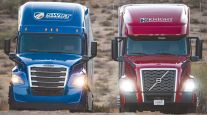Truck Sales Show Gains for Third Year
This story appears in the Dec. 24 & 31 print edition of Transport Topics.
Heavy-duty U.S. truck and engine makers appear headed for a third straight year of sales growth, although the trend may have peaked in August as volumes stumbled after that and new order rates dipped.
Most OEMs posted continuing double-digit growth in heavy-duty U.S. retail truck sales through November — 17.4% on average — except for Navistar International Corp., which experienced profound changes in management personnel and manufacturing strategy.
The Lisle, Ill., company had stood alone in its approach to engine technology for meeting the federal government’s 2010 standards on nitrogen oxide emissions. It went with a third generation of exhaust gas recirculation, while all other OEMs went with selective catalytic reduction as their aftertreatment technology.
Navistar came close to meeting the standard but had to pay penalties to the Environmental Protection Agency for selling nonconforming engines. In July, the company yielded on EGR and said it would offer SCR power plants, either 15-liter models from Cummins Inc. or its own 11- and 13-liter MaxxForce engines coupled with SCR after-treatment from Cummins.
At the end of August, Daniel Ustian retired suddenly after almost 10 years as Navistar’s top leader. Later, Deepak Kapur retired as vice chairman and James Hebe, a senior vice president, also departed.
Lewis Campbell, retired chairman of diversified manufacturer Textron Inc., succeeded Ustian as chairman and CEO, and Troy Clarke was promoted from within Navistar to become chief operating officer.
The two men pledged to return Navistar to profitability within 12 to 18 months, declared North American trucks and engines as the company’s prime focus and said they would scrutinize subsidiaries carefully for their ability to generate a return on invested capital.
Navistar’s switch to SCR means OEMs now have a united approach for fighting NOx and particulate matter, but truck and engine makers also spent much of the year talking about regulatory changes coming in 2014 and 2017.
NOx and PM standards appear for now to be as tight as they can get, so EPA and the National Highway Traffic Safety Administration are looking instead at emissions of carbon dioxide and other greenhouse gases.
Daimler Trucks North America said its truck lineup already meets the 2014 standard, and Cummins said its ISX15 meets the engine standard for that year. Other truck makers said they are on schedule to comply with the rule before January 2014.
Also, Daimler announced on Dec. 10 that it was creating two new assembly lines for transmissions and turbochargers. DTNA President Martin Daum said the transmission line, which will be the first to make transmission outside of Germany, will be online by late 2015. He also said he is on a “mission to convert the North American truck market to automated manual transmissions.”
DTNA’s other new assembly line will produce new asymmetric turbochargers for its new Detroit branded heavy-duty engines.
While changes in NOx and PM regulation tended to make truck engines less fuel-efficient, the greenhouse-gas rules are met by improving miles per gallon, always a highly sought-after quality among truck buyers.
Meanwhile, truck and engine OEMs made plain their interest in natural gas in March. All four truck makers and Cummins featured natural gas options at their exhibits at the Mid-America Trucking Show in Louisville, Ky. Navistar attracted oilman and investor T. Boone Pickens to participate in a panel discussion on natural gas at the start of MATS.
Shipments of new trailers also improved during the year. As with truck sales, trailers plunged to ruinous lows in 2009 but have been improving since then, according to registration figures from R.L. Polk & Co. Trailer manufacturing is not covered by the EPA/NHTSA greenhouse-gas standards, but manufacturers of trailers and trailer accessories appealed to fleets with products designed to reduce aerodynamic drag, thereby improving fuel economy.
Other truck makers with significant North American personnel changes were Peterbilt Motors and Volvo Trucks.
Former Kenworth Trucks General Manager Bill Kozek was named Peterbilt GM at the start of the year, replacing Bill Jackson, who moved to an executive position with Paccar Inc., the parent company of Kenworth and Peterbilt.
Ron Huibers, the North American president of Volvo Trucks, moved to a similar position at Volvo Group’s Penta unit, which makes marine engines. Göran Nyberg replaced Huibers at Volvo Trucks and reports to Dennis Slagle, who still is the CEO of Volvo Trucks and Mack Trucks in North America.




